
Eremophila divaricata, also known as spreading emu bush, is a flowering plant in the figwort family, Scrophulariaceae and is endemic to Australia. It is a shrub with stiff, spreading, tangled branches which are often spiny on their ends, erect leaves and mauve to lilac-coloured flowers.

Eremophila freelingii, commonly known as limestone fuchsia or rock fuchsia bush, is a flowering plant in the figwort family, Scrophulariaceae and is endemic to Australia. It is a shrub with sticky, hairy, lance-shaped leaves and flowers a shade of light to dark lilac and which occurs in Queensland, New South Wales and South Australia.
Eremophila eriocalyx, commonly known as desert pride, is a flowering plant in the figwort family, Scrophulariaceae and is endemic to Western Australia. It is an erect shrub with greyish leaves, very hairy sepals and petals that range in colour from white to yellow, sometimes pink or purple.
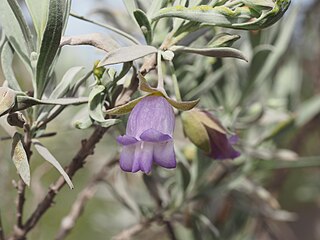
Eremophila maitlandii, commonly known as Shark Bay poverty bush, is a flowering plant in the figwort family, Scrophulariaceae and is endemic to Western Australia. It is a silvery-grey shrub with linear leaves and lilac-coloured to light purple flowers and is common in coastal areas between Shark Bay and Carnarvon.

Eremophila racemosa, also known as showy eremophila, is a flowering plant in the figwort family, Scrophulariaceae and is endemic to Western Australia. It is an erect shrub with glabrous leaves, small, green sepals and flowers which have many colour variations and which change as they age.

Eremophila gibbifolia, commonly known as coccid emu-bush, is a flowering plant in the figwort family, Scrophulariaceae and is endemic to Australia. It is a small, rare shrub in the wild, found only in Victoria and South Australia. It has small, fleshy, lumpy leaves and lilac-coloured to purple flowers, spotted inside.

Eremophila weldii is a flowering plant in the figwort family, Scrophulariaceae and is endemic to Australia. It is a shrub with glabrous green leaves, small sepals and purple or lilac-coloured petals and it occurs in arid and semi-arid areas of Western Australia and South Australia.

Eremophila hughesii is a flowering plant in the figwort family, Scrophulariaceae and is endemic to Australia. It is spindly, glabrous shrub with narrow leaves and with flowers that vary in colour from blue to pink, sometimes white. It is native to Western Australia and the Northern Territory.
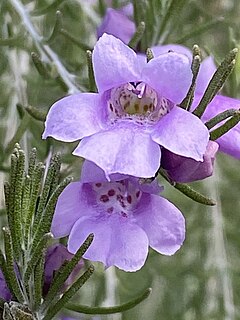
Eremophila microtheca, also known as heath-like eremophila, is a flowering plant in the figwort family, Scrophulariaceae and is endemic to Western Australia. It is an erect shrub with densely hairy branches and leaves, narrow leaves and pale lilac-coloured flowers and which emits a strong odour.
Eremophila crassifolia, commonly known as thick-leaved emubush or trim emubush, is a flowering plant in the figwort family, Scrophulariaceae and is endemic to an area extending from New South Wales through Victoria to southern parts of South Australia. It is a low, spreading shrub with clustered leaves and bell-shaped, usually mauve-coloured flowers.

Eremophila densifolia is a flowering plant in the figwort family, Scrophulariaceae and is endemic to the south-west of Western Australia. It is usually a low, spreading shrub with densely clustered leaves and lilac to purple flowers.
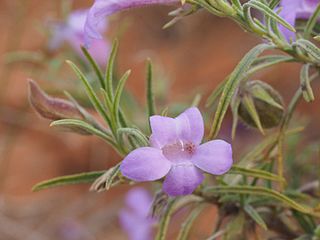
Eremophila gilesii, commonly known Charleville turkey bush, green turkey bush, desert fuchsia and Giles emu bush is a flowering plant in the figwort family, Scrophulariaceae and is endemic to Australia. It is usually a low, spreading shrub with pinkish-lilac to purple flowers and is widespread in the Northern Territory and all mainland states except Victoria. It is considered a difficult agricultural weed in some parts of Queensland but is often used as a bush medicine by Aboriginal people.
Eremophila phillipsii is a flowering plant in the figwort family, Scrophulariaceae and is endemic to Western Australia. It is a tall, erect, open shrub, with narrow leaves and lilac to purple flowers which are white with purple spots inside. It often has an offensive smell.
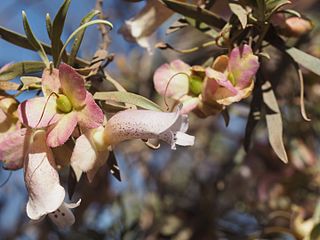
Eremophila platycalyx is a flowering plant in the figwort family, Scrophulariaceae and is endemic to Western Australia. It is a shrub or small tree with its branches and leaves covered with a layer of matted hairs, although the hairs are sometimes obscured by resin. The shape of the leaves is variable, depending on subspecies, the sepals are often brightly coloured and the petals are cream-coloured, sometimes spotted on the outside. Two subspecies have been described but others have been discovered although not as yet formally described.

Eremophila polyclada, commonly known as twiggy emu-bush, flowering lignum, lignum fuchsia and desert lignum is a plant in the figwort family Scrophulariaceae and is endemic to Australia. It is a dense, spreading shrub with narrow leaves and white to pale lilac-coloured, purple-spotted flowers. It occurs in all mainland states except Western Australia.

Eremophila psilocalyx is a flowering plant in the figwort family, Scrophulariaceae and is endemic to Western Australia. It is an erect shrub with a broom-like shape, narrow, hooked leaves and white, pink, blue or purple flowers. It is common in the mallee country around Esperance. It was sometimes incorrectly known as Eremophila pachyphylla.

Eremophila resinosa, also known as resinous eremophila, is a flowering plant in the figwort family, Scrophulariaceae and is endemic to Western Australia. It is a spreading shrub with sticky young foliage, short leaves, small sepals and mauve, purple or sometimes white flowers.

Eremophila rotundifolia is a flowering plant in the figwort family, Scrophulariaceae and is endemic to Australia. It is a shrub with many tangled branches with its leaves and branches covered with a layer of silvery-grey hairs. Its flowers range in colour from pale to deep lilac. It is common in South Australia and there is also a single record from the Northern Territory.
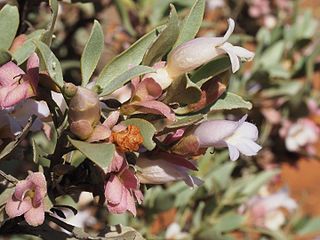
Eremophila tietkensii is a flowering plant in the figwort family, Scrophulariaceae and is endemic to Australia. It is a rounded to flat-topped shrub with grey-green leaves, usually pinkish-purple sepals and mauve, pink or lilac-coloured petals. It is mostly found in Western Australia but also occurs in the far west of the Northern Territory.

Eremophila willsii is a flowering plant in the figwort family, Scrophulariaceae and is endemic to Australia. It is an erect shrub with bright green, often serrated leaves and pinkish to deep pinkish-purple petals. It is mainly found in Western Australia, the Northern Territory and South Australia in deep sand.


















